Return of the Street Fighter, The Street Fighter, The Streetfighter's Last Revenge (1974)
Directed by: Shigehiro Ozawa
Written by: Hajime Takaiwa, Koji Takada, Masahiro Shimura, Motohiro Torii, Shigehiro Ozawa
Starring: Goichi Yamada, Masafumi Suzuki, Masashi Ishibashi, Reiko Ike, Sonny Chiba, Yôko Ichiji
THE STREET FIGHTER TRILOGY
The Street Fighter series is what propelled Sonny Chiba to cult status in the West and probably remain his best known films in which he was the main star, Quentin Tarantino then giving them a second boost when Christian Slater and Patricia Arquette go to a cinema showing of the first two films plus Sister Streetfighter in True Romance. Arrow Video have already released some other Chiba outings and even the follow-up Sister Streetfighter trilogy; here at last they bring the original trilogy to fans!
AVAILABLE ON BLU-RAY: 17th April, from ARROW VIDEO
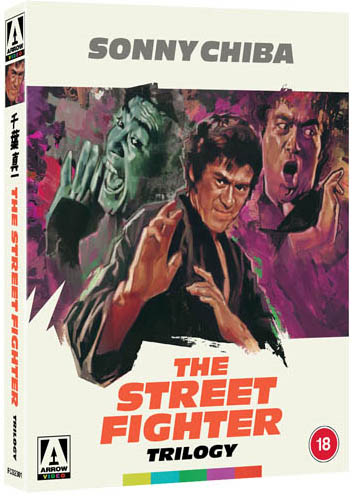
DISC ONE
THE STREET FIGHTER [1974]
AKA GEKITOTSU! SATSUJIN KEN
RUNNING TIME: 91 mins
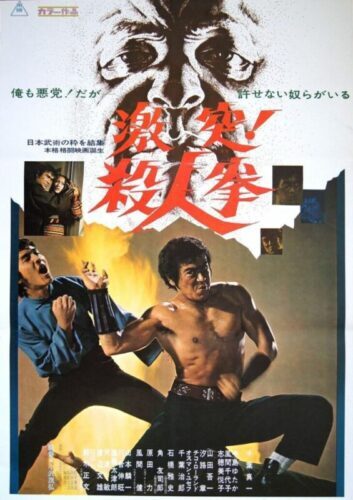
Takuma Tsurugi kicks ass for a living. He’s the best of the best in Japan and is hired to get murderer Tateki Shikenbaru on death row out of prison. He succeeds, but when Shikenbaru’s brother Gijun and sister Nachi plead for more time to pay, Tsurugi refuses, kills Gijun and sells Nachi into prostitution, making Shikenbaru his most bitter enemy. The pimp who now “owns” Nachi, Renzo Mutaguchi, then asks Tsurugi to kidnap oil heiress Sarai, but Tsurugi refuses when he learns that Mutaguchi and his men are yakuza, and an encounter with a ghost from the past makes him want to protect Sarai instead. However, you don’t just turn down the yakuza, do you?
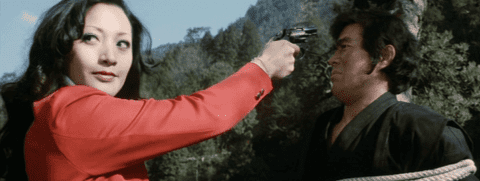
The term “badass” is bandied about too often, but Sonny Chiba’s Takuma Tsurugi [aka Terry Suguri in the English dubbed versions] is one character to whom the term can definitely be applied to. Chiba’s absolute commitment to doing everything in the most macho, accentuated way possible may very well bring chuckles to some viewers today; some of his poses are just weird, not to mention his stutter-steps as he faces off with opponents, and perhaps above all that bizarre breathing that he does between bashing people. His character is also able to jump out of windows and land standing up on trucks, and bounce off rocks and turn in the air several times before falling down cliffs. But all this just adds to the entertainment value of this semi-classic martial arts exploitationer which makes a good attempt to throw genre conventions out of the window in an orgy of pure power and damage, and would you want to mock to his face someone who can pierce eyes, smash heads and – in perhaps the two crowd pleasing gore highlights – rip out throats and penises with such conviction, Chiba making us believe that he can actually do all this. And Suguri is never, ever someone you want to offend, or indeed annoy. He’ll repay you thrice-fold. In fact he’s such a mean mutha that, in one of the two subplots of this film which gradually intersect more and more in Kôji Takada and Motohiro Torii’s rather neat script which emphasises two very different sides of the Suguri character as if it’s asking us which one do we believe more, he’s basically the villain. The guy out for revenge, Shikenbaru, is someone we can get behind, because all he did was not pay Tsurugi some money and the lovely Tsurugi decided to make his sister a hooker. Nice guy. It had been some considerable time since I’d seen The Street Fighter, but it’s still immensely effective, maybe not art but pretty successful at what it does, its sheer rawness and lack of interest in letting goodness in except for a few very well handled moments remaining fresh and even vital.
We begin with a shot of a door opening revealing a rope. Shikenbaru has been sentenced to death. “He’s a karate master”, says one of the guards to the other in the English dub [I went back and forth between the two versions because I partly wanted to replicate the grindhouse viewing experience, but I promise I’ll watch the sequels mostly in the original Japanese], “a mean bastard from Okinawa…..he’s killed seven men so far, he must think he’s Bruce Lee”. Into his cell comes our Tsuguri disguised as a Buddhist monk who says that he goes around all the prisons visiting the condemned. He asks if he can speak with Shikenbaru alone. “I want to have a match with you, then I might crush you till your heartbeat stops” says Shikenbaru. A brief slow motion fight ensures until Tsuguri smashes him on the back of the neck. “You’ll be unconscious soon from lack of oxygen” says Tsuguri, “it’s an ancient technique”. The Japanese language version just says it’s “Delayed asphyxia”. Just as he’s being led to the gallows, Shikenbaru collapses and is rushed to a hospital. Tsuguri and his sidekick Rakuda [or Ratnose in the English dub]) ambush the ambulance and free him. Shikenbaru ‘s brother Gijun and sister Nachi plead for more time to pay for Tsuguri’s help. Outraged, Tsuguri refuses and, after kissing her, threatens to make Nachi walk the streets unless he gets the money now. A fight ends with Tsuguri dodging Gijun’s flying kick, causing him to go out of a window in a funny moment. While it’s true that most martial arts films of the period, whether Japanese or Chinese, tended to contain fantastical moments where fighters leap in the air, I do wonder if such absurd bits here like the one just described – and there are several others – were deliberately inserted in an attempt to soften what is an often grim story set in a brutal mileau. Of course they jar with scenes such as, a few moments later, a struggling Nachi being held down so a guy can have his way with her.
So that’s the first subplot set up, with Shikenbaru and Nachi eventually coming back into the story, and being sympathetic so that we want Shikenbaru to kill Tsuguri. It’s an interesting attempt to play with the viewer’s feelings, especially as Tsuguri is rather different in the second subplot which takes over for a while. Sarai’s father has just died and she’s inherited a hell of a lot of money. “Oooh, you’re going to be surrounded by vultures”, she’s told, but that’s an understatement. Mutaguchi, the pimp now in charge of Nachi, and two associates attempt to hire Terry to kidnap Saria, but he says no when he sees a yakuza tattoo, though in the English dub he’s not very knowledgeable about some things when he refers to the yakuza as “The notorious Hong Kong assassination ring”. He escapes, but the gangsters decide to kill Tsuguri as well as kidnap Sarai anyway. Tsuguri immediately seeks out Sarai for himself, who’s being protected at the Nippon Seibukan dojo by her uncle, Kendi Masaoka. Tsuguri punches through a door, grabs Sarai and forcibly snogs her before putting his hand on her throat so he can hopefully take her away without being attacked. Okay, up to now Tsuguri’s the same nasty bastard we’ve seen before, but he has a rather quick change of heart when Masaoka recognises him as the half-Chinese son of a master he knew long ago “Who combined Chinese boxing with Japanese karate” in a brief black and white flashback showing the young Tsuguri being denied access to his “traitor” father and “whore mother” before seeing his father shot. We don’t learn any more details about all this, but it clearly made Tsuguri the man that he is now, words from his dad like “Trust no-one” ringing in his head. So now, and seemingly without being offered or asking for money, will protect Sarai [if against her wishes] – and when Tsuguri protects someone, he’ll do it 110%, though he has not just Shikenbaru after him but gangster groups in both Japan and Hong Kong. Things become virtually a series of fights, which is just how we like it.
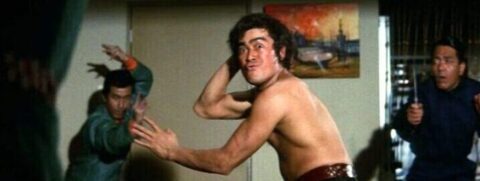
Like the best martial arts movies, The Street Fighter likes to surprise sometimes. When Tsuguri breaks into the karate dojo, he easily bests a few students before Masaoka fights him. Masaoka is old and portly, but hurls Tsuguri all over the place and battles him to a standstill. An altercation in a teahouse does not lead to a big fight. If only the scene of some gangsters seeing a blind man in the middle of the road who suddenly pulls a sword out of his stick and reveals himself to a modern-day variant of Zatoichi was said character’s first scene, not his second. With rough, even crude, choreography which totally avoids the gracefulness of Hong Kong martial arts but which is appropriate to Chiba’s style, the brawls mix extensive and accurate karate moves with occasional wirework and extensive damage to heads, arms, whatever’s at the receiving end of Chiba’s hands and feet, with lots of blood which looks similar to but isn’t quite the same as the iconic Shaw Brothers blood that Tarantino had duplicated when he made Kill Bill: Volume 1 which had a great if small role for Chiba. The first full fight is when a bunch of nasties burst into where Tsuguri and Rakuda are training. Tsuguri makes short work of all of them except for one who clearly thinks that he’ll be spared; he gets his teeth punched out for his troubles. After the quite lengthy dojo section, the two are in their car and narrowly – not to mention unbelievably – survive death in an oft-employed way before Tsuguri wastes their attackers. His fight with the Zatoichi-like character is introduced with repeated closeups of faces though there’s not much actual exchanging of blows, but Tsuguri making his way through villain after villain on a ship is gratifyingly vicious, with the bloodshed really being upped, and the final Tsuguri and Gijun encounter takes place in a blizzard. Tsuguri’s final scene may confirm suspicions that the filmmakers weren’t sure what to do with the character, a character as bad as he’s good. But he has his own code of honour which he rigidly sticks to, and even emotes a tear at one point when said code of honour has not worked out well for him. The script seems to occasionally be critical of Tsuguri’s attitudes.
Chiba is a force of nature, and has enough presence so that simply contorting his face is able to convince the viewer of his immense power, certain visual devices such as showing an x-ray of a smashed skull, devices which no doubt seemed really original at the time not really being neccesary. Gochi Yamada as Rakuda is rather pointless. His interplay with Chiba reaches no further comedic heights than Tsuguri complaining about being fed the same chicken dinner by Rakuda, who’s soon relegated to standing by while his friend [or rather master] busts asses and saying stuff like “We don’t know what’s going to be next, what shall we do”? Chiba and Yamada do share chemistry but the script, in either version, doesn’t give them much to work with together, and eventually Yamada is required to just whimper for ages, though the relationship does end up being genuinely emotionally involving. Elsewhere, future Sister Streetfighter Etsuko Shihomi as Nachi has to cover some weight of a similar kind but doesn’t quite do so. The Street Fighter is a film where females are either sexual fodder or villains, and where a black character is solely defined as being a rapist, but of course it wasn’t intentionally sexist or racist, and I yearn for the freedom of old; we’re unlikely to get such an un-PC main protagonist in a film today without explicit condemnation. Kenji Tsukagoshi’s cinematography is quite inventive as it often employs odd angles, and gives us one rather beautiful scene where the sun shining on water results in lots of crosses, while Toshiaki Tsushima’s music begins the film with a cracking main theme that you’ll remember for a while, though it’s not used often, the score instead emphasising quiet tracks for the emotional elements, which is perhaps surprising for a film largely going for excess and supposedly lacking heart. It remains wonderfully guilty fun despite not always seeming to know what sort of film it wants to be and intrigues us with its sometimes conflicting attitude to its main character.
SPECIAL FEATURES
Brand new 2K restoration of the original Japanese and American versions of the film from the original camera negative
Boy does The Street Fighter look good. I don’t own the Shout Factory set, but I know that its 2K scans of the films were sourced from different versions, resulting in differences in the picture quality. Toei recently did new restorations but these were apparently very flawed in terms of colour, so Arrow got access to the original raw scans and did their own versions. This one is wonderfully clear and crisp with very vivid colours and mostly even grain, while some black crush and occasional hue saturation are actually welcome because they help the film retain its rough, low budget aesthetic. As I mentioned before, I alternated between the two versions while watching, even though had to keep going back and start again because the opening titles differ; you can’t just change audio with one button. The English dub is full of obvious westerners trying to sound Japanese, but what probably comes across as disrespectful today was no doubt thought of as being exactly the opposite at the time, though there’s the rather condescending comedic line “Who do you think you’re talking to, Madame Butterfly”? , not to mention little attempt to have words match lip movements. New Line Cinema also gave the film new titles and changed the first name of every listed cast and crew member so they were western names, as well as altering a few character names..
Brand new audio commentary by Asian film specialists Andrew Heskins and James Mudge of easternkicks.com
I hadn’t heard these two chaps before, so I had no idea what to expect from this track. They got on my right side immediately by Heskins saying “This is not going to be a deep dive into the credits of every cast and crew member” before admitting that they’re recording while “having a wee drink” and suggesting the viewer gets him or herself one too. However, we don’t get much production or release information either [I wanted to learn more about the various cut versions prepared for western audiences], and there’s little scene-specific chat, but the conversations about elements of the film, from personal viewing recollections to its place in cinema, are a nice listen; maybe we don’t learn much, but we get a lot of insight, such as its distasteful aspects probably preventing it from being as popular as it could be. They like the film a great deal but aren’t fanboys blinded by adoration. Their chat about Tarantino is also very even handed. A good track, if perhaps different from what you may expect.
Street Fighting Man, an interview with Sonny Chiba [27 mins]
This and the following featurette were on the Shout Factory release. You may wish to watch them after seeing all three films because it shows clips from all of them. Chiba is candid here with regard to The Streetfighter; he’s happy it’s being released in this way, but has always disliked the way it focuses on killing and extreme violence, even if he does say that some of the damage to human bodies that we see is accurate, or at least would have been back when karate masters had more skill, and that even his breathing is an actual technique employed when you’re tired. He likes his character, but I do now wish that he’d made a film where he was able to present his own view of karate. He had to do what studios wanted, and he’s finished with all that now, wanting to play a character like Dirty Harry! Chiba suggests that all Japanese should study budo which in reality is more philosophical and more about living well, restrains himself from talking about World War 2, and tells of Jackie Chan’s visit to him which suggests that Chiba was the main reason why Chan didn’t use a stuntman [well, rarely!]. This chat reveals a proud and still ambitious but also slightly regretful and humorous Chiba. A must-listen.
Cutting Moments, interview with director Jack Sholder discussing his role in creating the legend of Sonny Chiba [13 mins]
Sholder, who eventually became a director, discusses his early career, which includes the great quote “I took some LSD and came to the conclusion that words were useless”, before going on to his time at New Line as a trailer editor and occasional English dub creator. Despite a somewhat snobby line about “a shitty kung fu movie” being much easier to get a trailer out of than a film that was good, Sholder provides some interesting stuff here. We’ve already heard how New Line’s honcho Bob Shaye travelled to Tokyo looking for the next Bruce Lee and watched loads of Toei’s martial arts movies, but here we learn that the Japanese lady who translated all these films into English because at the time they had no subtitles found The Street Fighter too gruesome and averted her eyes, which made Shaye be suddenly very keen on this one.
Original Japanese and U.S. theatrical trailers
Image gallery
DISC TWO
RETURN OF THE STREETFIGHTER [1974]
AKA SATSUJIN KEN 2, BLOOD OF THE DRAGON
RUNNING TIME: 88 mins
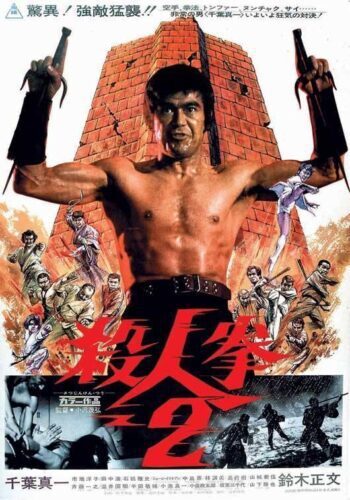
Takuma Tsurugi is still kicking ass for a living. His latest assignment has been given to him by Isamu Otugaru, owner of the Ryukoden karate school but also a member of the yakuza, with the school just being a front for his organisation – though he seems most interested in building something called The Pan-Asian Martial Arts Center. Tsurugi has to kill two men; Rio Grado, who’s stolen a valuable statue, and Gentoku Ryu, who’s gone to the police and might tell them everything. Tsurugi completes his tasks but is reluctant to carry out another, that of killing Kazuko Masaoka, the head of the Seibikan karate school, because he knows him and his father had even been friends with him. This makes him a target for not just the yakuza but also the mafia with whom Otugaru is involved with, plus an old enemy….
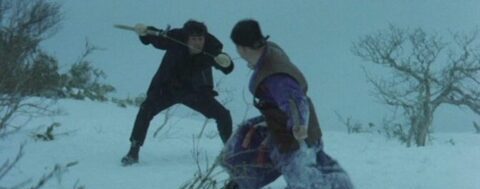
The first film seemed to present two slightly different Tsurugis and ask us which is the real one. Toei then decided for us in the first sequel; it’s the slightly nicer one which does have a moral compass and a heart, then continued just a little bit further in that direction. And this isn’t at all surprising; quite often tough or difficult characters get toned down in follow-ups. In fact if you disliked The Streetfighter because of the way both the title character and the script treated women, then you may enjoy Return Of The Streetfighter more, though the extreme violence, surely The Streetfighter‘s main attraction along with Chiba, has been lessened, a strange choice when you’d have thought they would have tried to up the ante, though there are still a few memorably gruesome moments, along with some more daft ones with Tsurugi displaying virtually superhuman abilities. Chiba is more relaxed in his part, but this sequel is still not quite as good a film overall. The fights are smoother and sometimes a bit more complex, which should please many, and Chiba is more relaxed in his part, but the film shows distinct signs of being a rushed and cheaper follow-up, from no less than three flashbacks showing footage from the first film to an awkwardly constructed script, with returning director Osawa this time writing the screenplay with Hajime Takaiwa, from a story by Kôji Takada who co-scripted the original film. They repeat a lot of its settings and situations as well as bringing back two characters, but can’t seem to make their actually quite decent plot hang together very well, while giving Chiba less screen time, almost as much emphasis being given to the rift between its two dojo masters and the cop investigating all these killings and money stuff. But I’ve possibly been a bit too negative, because there’s still a lot of fun to be had here.
A suitcase containing twenty million yen is the first thing that we see. This is what Tsurugi is being paid to kill two men. He heads for the police station where Ryu, the more immediate target, is being interrogated, cue a pretty goofy sequence that’s far longer than any of the sillier passages in the first film which were relegated to small moments. Tsurugi is speeding on his motorbike, so he soon attracts the attention of a police bike and a police car, both of which give chase. The bike crashes, and Tsurugi drives his so that it jumps over it, then hits the gate of the police station while he somersaults over the gate. After beating up a number of cops he’s handcuffed at gun point, but overcomes the two who are taking him to a cell when he notices Interrogation Room No. 8 which is where Ryu is, and kicks his way into there despite the wall being made of bricks, where, despite still being cuffed, he defeats some more policemen including another one who does karate and whose style he notices, but you get no lengthy displey of skill and prowess here, the fight ends up in a few seconds. He presses two of his fingers into Ryu’s throat to silence him forever but to not actually kill him, which isn’t what we’re used to from Tsurugi. Just a few seconds is all he needs to smash the bars of a window through which he can escape to a car where his new sidekick, a girl named Pin Boke, is waiting. His second target is watching a film [Battles Without Honour And Humanity: Police Tactics] which involves a street chase with people getting gunned down; in a nice conceit which shows some self-awareness, he leaves and while trying to protect the gold statue which he has in his possession, gets involved in a similar situation where he shoots some people. Could the film actually be suggesting that such films are a bad influence? Surely not. It’s worth noting that there was a lot of gun violence in Japan at the time. The guy who gave Tsurugi these jobs Otugaru, head of the Ryukoden karate school, is worried that the police might have an informer, and thinks it’s the head of the neighbouring Seibikan Masaoka school, but, in the first of many awkward story points, would Masaoka really know all that much about his activities?
Meanwhile cop Masashi Ishibashi, who was supposed to be protecting Ryu and, when told off for his failure, resigned but decided to stay involved with the case, visits Masaoka and both are suspicious about Otugaru. He seems to be obtaining loads of money but how is he getting it? He may be involved with the mafia, who will soon take over from the yakuza in this movie, unless they’re supposed to be the same or the subtitles aren’t quite right, but they’re mostly non-Japanese. Ishibashi and Masaoka also reckon that the killer of these two villains could be the notorious Tsuguri, but Ishibashi seems like the main protagonist for a short while, Tateki Shikenbaru even getting quite a good fight scene where he bests some hoods in several offices, while Masaoka visits Otugaru to tell him his suspicions, which may not be that sensible but remember Masoaka is an honest man. Tsurugi has a voice on the radio tell him to go to a train station where a street seller gives him a key with the number of a safe on it; inside the safe is a lot of money and instructions for his next job, but he doesn’t want to kill Masoaka, causing henchmen to try to kill him at every opportunity. However, that’s not just it. Tateki Shikenbaru is back in town, even though it seemed as if Tsurugi killed him before. No, he’d just ripped out his throat, a problem that can apparently be partly solved by the putting in of a voice box. As for Tsurugi, even losing a fight and being out cold for three days isn’t really a problem when, upon waking, he pours some kind of alcohol over himself, then drinks some from the bottle and spits some of it out on his skin, and – hey prestoQ – he’s ready for action again. Huh?
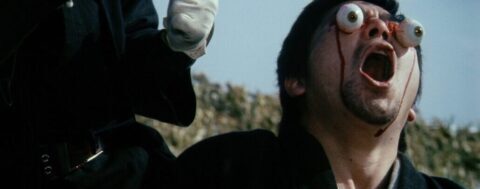
The plot actually dominates for a while and, while it largely hinging on whatever nefarious thing Otugaru and the mafia, it’s quite believable. In addition to the flashbacks, one of which was also a flashback in The Streetfighter, there’s a long section of padding, taking us around the two schools where we see students training with various weapons and smashing things with hands, feet and heads, with even a vignette with a little girl who has trouble chopping some wood but becomes very tough and aggressive during some sparring. When the fights begin in earnest and pile up, there’s a bit more fluidity and use of weapons. Tsurugi is first properly attacked on snowy hills, with Boke understandably asking him why they went there, by three armed assailants; a blizzard begins and we finish with perhaps the violent highlight, as a punch on the head causes eyes to pop out. Then, after he’s had to contend with an irritating guy warbling on about karate who nonetheless privides some laughs, he has to battle a gang in a sauna where everybody is wearing pants. In a lift a woman, who we unfortunately already know to be a villain [this scene would work better if we didn’t] comes on to him in a lift, but when in bed with her she also tries to kill him. Then a street encounter with the Arab World’s greatest karate master who’s rather quickly slain leads to a faceoff with Shikenbaru which for a bit makes good use of sies versus a metal bar, though the return bout is also a little short, even if we remember that we shouldn’t expect long battles. The action highlight is probably when Tsuguri dispatches villain after villain all over Otugaru’s headquarters, often using a belt; the viciousness isn’t on the level we saw in the equivalent sequence in film number one, but the staging is better.
Throughout the action the takes are longer and there’s good use of slow motion, though Sadaji Yoshida’s cinematography also employs some “shakycam” which makes one particular scene very dizzying. While Boke’s love of traditional Okinawan music is about the best it gets in terms of would-be humour, she’s a better companion for Tsuguri than the slave-like Rakuda, even sensibly not going with him everywhere. Their story develops in a way somewhat like Tsuguri and Rakuda’s did, and ends up achieving another emotional response in its climax, but there are also noticeable differences as well. Tsurugi is a bit of a nicer guy, though he’s not required to forcibly kiss any woman he comes across anyway, and you still wouldn’t want to piss him off. Chiba manages this evolvement pretty well, the more laid back nature to his performance being suited; of course he still does his exaggerated mannerisms while engaging in combat, though even they’ve been slightly toned down, albeit while still keeping the essence of his style. Toshiaki Tsushima’s music score is more prevalent and lighter in this one too. My overall attitude to Return Of The Street Fighter can be summed by; I think it’s an inferior film, but I can understand why some will prefer it.
SPECIAL FEATURES
Brand new 2K restoration of the original Japanese and American versions of the film from the original camera negative
Return Of The Streetfighter is another stonking restoration; my comments for The Street Fighter‘s picture quality also apply here. I only checked out the English dub a few times, but it’s much like the one for the earlier film.
Brand new audio commentary by Jonathan Clements, author of A Brief History of the Martial Arts
Clements often tells what’s happening on screen, but he can be forgiven since he’s going solo, and he delivers a good track overall, actually disscussing a broader range of topics than Heskins and Mudge, and sometimes using employing some slight mickey-taking without turning into outright mockery, making for a nice balance overall. Topics range from Chiba originally being the comic relief but gradually inching his way into being the main star in Key Hunter, the TV series which propelled him to fame, to the sie originally being a police weapon to disarm people with swords, to the Seibikan dojo being the real name of the dojo that we see used in real life, with Masaoka as its real master. He doesn’t like Boke, calling her “an irritating and childish stereotype”, and, curiously in this day and age, he’s not sure if the eye-popping scene will get through the BBFC even though the film was uncut on DVD.
Original Japanese theatrical trailer and U.S. teaser and theatrical trailers
Image gallery
DISC THREE
THE STREET FIGHTER’S LAST REVENGE [1974]
AKA GYAKUSHU! SATSUJON KEN
RUNNING TIME: 83 mins

Takuma Tsurugi is hired to rescue gang boss Go Owada from a police riot in exchange for a hefty payment, but when he goes to collect his loot, he’s handed a bag of cut-up newspaper instead, and understandably lashes out at the mobsters present, causing the Owada family to go after him. Then he steals a tape recording of an incriminating conversation between Go’s younger brother Seigan and a politician, Mr. Iizuka, he was trying to blackmail. Contract killer Huo Feng is supposed to kill Tsuguri for the Owada’s, but wants to align herself with Tsuguri when they hire a former Mafioso from Chicago, Frankie Black, to help. Go and Seigan’s sister Aya decides to go after Owada in her own way, but prosecutor Takera Kunagami is also after the tape….

It seems that a case of diminishing returns is the usual verdict on this trilogy, but as I type I’m not entirely sure that this is the case. I first saw these films on bootleg video [no I’m not a young man], and of course it was the extreme viciousness and amorality of the first instalment which I liked best, followed by the second, then followed by this third episode which goes a bit James Bondy and tones down the elements that made The Street Fighter so unique so much that it felt like it belonged in another series altogether for some of the time. There wasn’t even a huge number of fight scenes, ruining the main point, wasn’t it? I retained that view for quite some time, but now, having watched it a great many years after my last viewing [as with the other two films], I actually rather like The Streetfighter’s Last Revenge, and because of some of the reasons that used to make me dislike it. Well, tastes change. The plot is definitely the strongest out of the three, and, while it’s easy to dislike the way that Tsuguri has been made into a much slicker character who wears disguises, attracts the ladies and has a bit more of a sentimental streak – something seen perhaps most notably in the scene where he warns somebody who’s betrayed him not to go to their deaths. The earlier Tsuguri would never have done such a thing. Nonetheless, some of his essence does remain. He’s still not really a moral person in that he remains a person for hire, and he still smashes his way through loads of bad guys, he just doesn’t do it as often in a film where double crosses are just as important, and the bloodletting really is toned down, though some moments still remain, especially towards the end such as the fate of the final villain, while there’s a bit more sex and nudity though. And, while I’m not a PC person at all, it’s nice to have more female characters and have them given some prominence and reasonably decent characterisation.
Shots of bustling streets suggest that we’ll going to go into the thick of the action right away, but before that we have an amusing sequence which shows already how different the attitude to the Tsuguri character is. We’re in an office where women are answering phones in a switchboard office, and Kimiko Yakayama has to put up with a prank caller before the girl working next to her transfers her latest caller to her, which is Tsuguri. They both seem to have a crush on this guy who’s clearly rang often but whom they’ve never met.” Doesn’t Mr. Tsuguri have a great voice, I’d love to know what he looks like”, asks Kimiko. Kimiko transfers him to the line where presumably he’s told the place to go where he’ll be told about his next task. Typical for Tsuguri, he wants twice the amount he’s offered when, in addition to getting mobster Go Owada out of a dangerous situation, he’s also asked to retrieve a Mahjong case. Now we see Tsuguri’s pad, as he goes all the way inside a cupboard full of clothes, head wear and masks. The police siege he has to go is just in the process of becoming a full-on attack, and Owada is fleeing with a suitcase but is kicked and handcuffed by a cop who gets him out and drives off in a police car while the credits appear, though not the film’s title; that will be a couple of minutes later. To the surprise of his prisoner, the cop pulls off a mask to reveal that he’s Tsuguri, saying “I make the impossible possible”. But Owada’s associates don’t pay up, leading to a brief fight, the gangsters leaving and Tsuguri to be attacked by a lady, Huo Feng, a contract killer presumably supposed to be out to kill him. “Go put on your makeup and start husband hunting” says a sexist Tsuguri. Meanwhile a shareholder’s meeting at Tokyo Chemical, headed by Ogawa’s younger brother Seigen, which has protestors both outside and inside, isn’t going very well. Apparently “a few hundred fisherman have been paralysed” by one of their products, and it’s revealed that eminent figures including the PM himself have been paid off not to do anything about their actions, though this potentially interesting element of the story isn’t followed through, and wouldn’t this information have had more impact later?
The conversation is being recorded so that a politician naked Mr Iizuka can be blackmailed to give them more money, but then all of a sudden a voice says “not so fast” and in drops Tsuguri to grab the tape before then disappearing. The Owada’s want to kill Tsuguri, and Aya is inspired to hire former mafioso Frankie Black after watching him tear apart a strong chain on live television, with a little bit of help from a laser which emits when he puts his hands together. He also wears a Mexican mariachi outfit including a sombrero. No, I’m not joking about any of this, though it’s not as goofy as the next few scenes. Kimiko asks Tsuguri out over the phone, and he turns her down, saying that he looks like Dracula [an odd choice seeing as Dracula is usually attractive to the ladies but never mind]. She goes to a club anyway, which by a strange quirk of fate turns out to be the same club where Tsuguri is supposed to be meeting Aya, who remember wants to get this tape back. Kimiko gets him to dance to one track but then he espies Aya so has to put Kimiko off, something he does in the strangest way. While dancing with her, he puts on a mask and some fangs so that when she sees him she’s terrified of him and lets him go, the two suddenly being bathed in green light. However, Aya doesn’t actually mind the makeup and goes to bed with Tsuguri! It’s easy to see why many fans of the first two were put off, but my partial answer to that is that even the first two films had their daft bits, they just tended to be restricted to portions of action such as incredible leaps to safety. Black and his crew machine-gun Tsuguri’s place while Aya makes off with the tape and somebody else, a guy named Takera Kumigami, a prosecutor in the legal profession, kidnaps Kimiko. We’re surprised several times by this character who has almost as much screen time as Chiba. As for Tsuguri, he has to go see Kendo Masaoka again when he’s defeated, cue that childhood flashback yet again, though this time it’s in blue. After some sparring, Masaoka tells him that “you’ve had too many fights, your mind is not clear”, though of course a lot more fights have to happen.

However, said fights don’t take over the plot in the way that we’ll used to, with characters changing and us not being quite sure as to how everything will play out, while if anything the fights show a bit more improvement in choreography, the lesser number and shorter duration of some of them allowing for more time to be spent on them. After a couple of skirmishes, the second one having Tsuguri leap over a car not once but twice, the first full brawl is when Tsuguri faces off with Kumigami for the first time in a playground, and more than meets his match. After reviving, largely thanks to Masoaka, he sets off for revenge but their next encounter is a surprise, with just one blow struck and an unexpected person getting not exactly in the way but certainly changing things somewhat. Guns including machine guns make even more appearances, most notably in a battle on a road where it’s not Tsuguri but Huo Feng who takes it to the villains, Etsuko Shihomi showing off some skills here. The action high point must be a fight with Black and a few goons in a room full of coffins, which really flows and makes creative use of the environment in a way Jackie Chan would have done a few years later, though why Black doesn’t use his lasers he’d previously displayed is strange. His demise is memorably cruel too. Tsurugi then has to fight Go, the two battling atop a hill before they both roll down it as the camera spins round and round, suggesting their point of view, to continue the fight on an airport runway even though they’d have more likely being very badly injured. Raging rain again forms a backdrop for the climax, perhaps even more effectively employed and certainly more evocatively photographed [even if it is movie rain and not real rain] by cinematographer Nagaki Yamagishi, while the fight has the most epic feel out of all the one-to-one showdowns in all these films, even if by the overall standards of these things it’s not really very long.
Ozawa and Yamagishi employ less “shakycam” this time around, though there are some strange audio effects to go along with Chiba’s usual antics. I wouldn’t be surprised if Chiba liked this one more than the first two, and not just because of there being far less bloodshed, nor the script having not one but three female characters fanch him, and two of them telling him that they’re in love with him. He looks like he enjoys being given the chance to act a bit more; he’s not great, but gets the job down. “Pinky Violence” [a subgenre of female-led sex and violence concoctions] icon Reiko Ike has a very strong presence and a surprisingly full-on sexuality as Aya; despite her villainous nature and in particular her deviousness we want her character to make it – though perhaps we think this because of the women were treated in the first film? Etsuko Shihomi isn’t anywhere near so strong in the role Huo Feng, presumably a Chinese character judging by her name which could have been interesting considering that Tsuguri is supposed to be half-Chinese, but the script by Koji Takada, returning to writing duties after a one-film break, and Masahiro Shimura could have given her more to work with then they actually did. Toshiaki Tsushima’s musical score uses the main theme more yet still has more diversity than the previous two ones he wrote for the trilogy. All in all The Street Fighter’s Last Revenge deserves a bit of re-appraisal. Clearly either nobody wanted to do an audio commentary for it, or Arrow didn’t think that anybody would so didn’t bother asking, yet I think there’s a fair bit to appreciate in it. Maybe it isn’t better than Return Of The Street Fighter, but it’s more interesting, which more often than not means “better” in my book.
SPECIAL FEATURES
High Definition (1080p) Blu-ray presentation of the original Japanese and American versions of the film
Unsurprisingly considering it’s from a normal HD print not a 2K restoration, The Street Fighter’s Last Revenge is slightly less impressive than the first two films in terms of picture quality, with especially less grain imbalance, though it’s certainly nothing to get annoyed about. Detail is still great and blacks may be better. This time around New Line Cinema, for its American release, made changes to the movie. I did know this, so checked out some of the American version which Arrow have also restored on this set. The tape revealing bribes paid to the government by a chemical company are altered in the American dubbing to a formula for synthetic heroin. Likewise, Huo Feng is now a lawyer who was planted undercover in the Owada clan, but uses the same reason to get out. To aid these alterations, some scenes have been rearranged. It all works quite well, even though the English dubbing is the worst out of the three.
Original Japanese and U.S. theatrical trailers
Image gallery
PRODUCT FEATURES
High Definition Blu-ray™ (1080p) presentations
Original lossless mono Japanese and English versions for all three films
Optional English subtitles for the Japanese soundtracks and optional English subtitles for the deaf and hard of hearing for the English soundtracks
Reversible sleeve featuring original and newly commissioned artwork by Tony Stella
FIRST PRESSING ONLY: Illustrated collector’s booklet featuring new writing on the films by Mark Schilling and Chris Poggiali
Distinctly superior to the North American Shout Factory release due to better prints and two audio commentaries, Arrow’s release of this trilogy might still be worth buying even for those who have the earlier set. “The Street Fighter” is an important exploitation cinema landmark but the sequels are pretty good too, especially in my view the rather maligned third film. Highly Recommended!






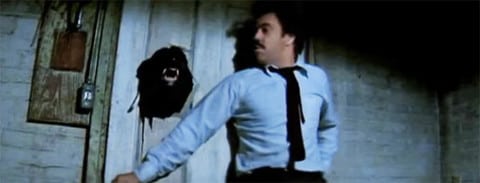
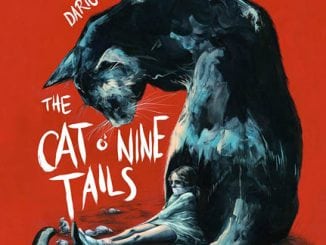
Be the first to comment